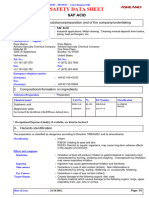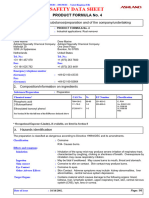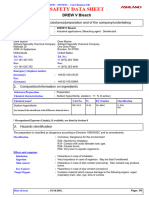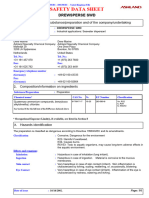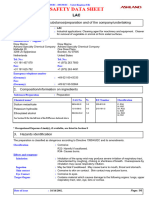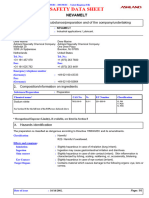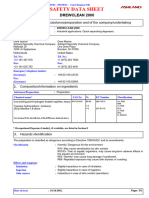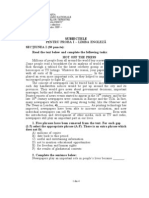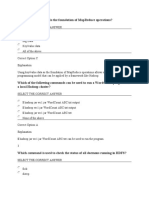9511 Lktjc5kub
9511 Lktjc5kub
Uploaded by
Nandar Min HtetCopyright:
Available Formats
9511 Lktjc5kub
9511 Lktjc5kub
Uploaded by
Nandar Min HtetOriginal Title
Copyright
Available Formats
Share this document
Did you find this document useful?
Is this content inappropriate?
Copyright:
Available Formats
9511 Lktjc5kub
9511 Lktjc5kub
Uploaded by
Nandar Min HtetCopyright:
Available Formats
Conforms to 91/155/EEC - 2001/58/EC - United Kingdom (UK)
SAFETY DATA SHEET
DESCALE-IT
1. Identification of the substance/preparation and of the company/undertaking
Product name : DESCALE-IT
Material Uses : Industrial applications: Rust and scale remover
Manufacturer / Supplier :
Drew Marine Drew Marine
Ashland Specialty Chemical Company Ashland Specialty Chemical Company
Malledijk 20 One Drew Plaza
3208 LA Spijkenisse Boonton, NJ 07005
Netherlands United States
Tel. No.: Tel. No.:
+31 181 457 070 +1 (973) 263 7600
Fax: Fax:
+31 181 625 792 +1 (973) 263 4491
Emergency telephone number
(Germany) : +49 621 60-43333
Fax:
(Germany) : +49 621 60-92664
2. Composition/information on ingredients
Substance/Preparation : Preparation
Chemical name* CAS No. % EC Number Classification
Hydrochloric acid 7647-01-0 20-30 231-595-7 C; R34
Xi; R37
See Section 16 for the full text of the R Phrases declared above
* Occupational Exposure Limit(s), if available, are listed in Section 8
3. Hazards identification
The preparation is classified as dangerous according to Directive 1999/45/EC and its amendments.
Classification : Corrosive
R34- Causes burns.
R37- Irritating to respiratory system.
Effects and symptoms
Inhalation : Hazardous in case of inhalation (lung irritant). Inhalation of the spray mist
may produce severe irritation of respiratory tract, characterized by coughing,
choking or shortness of breath. Overexposure by inhalation may cause
respiratory irritation.
Ingestion : May be fatal if swallowed. May cause burns to mouth, throat and stomach.
Skin contact : Corrosive to skin on contact. Skin contact may produce burns.
Eye Contact : Corrosive to eyes.
Target Organs : Contains material which causes damage to the following organs: lungs, liver,
skin, eye, lens or cornea.
Date of issue : 10/16/2002. Page: 1/5
DESCALE-IT
4. First-aid measures
First-Aid measures
Inhalation : If inhaled, remove to fresh air. If not breathing, give artificial respiration. If
breathing is difficult, give oxygen. Obtain medical attention immediately.
Ingestion : Do NOT induce vomiting unless directed to do so by medical personnel.
Never give anything by mouth to an unconscious person. Loosen tight clothing
such as a collar, tie, belt or waistband. Get medical attention if symptoms
appear.
Skin contact : In case of contact, immediately flush skin copiously with water for at least 15
minutes while removing contaminated clothing and shoes. Cold water may be
used. Wash clothing before reuse. Clean shoes thoroughly before reuse.
Obtain medical attention immediately.
Eye Contact : Check for and remove any contact lenses. In case of contact, immediately
flush eyes with a copious amount of water for at least 15 minutes. Cold water
may be used. Obtain medical attention immediately.
5. Fire-fighting measures
Extinguishing Media
Suitable : Not applicable.
Unusual fire/explosion Hazards : Flammable hydrogen gas may be produced on prolonged contact with metals
such as aluminium, tin, lead and zinc.
Hazardous thermal (de)composition : These products are halogenated compounds.
products
Protection of fire-fighters : Fire fighters should wear self-contained positive pressure breathing apparatus
(SCBA) and full turnout gear.
6. Accidental release measures
Personal Precautions : Splash goggles. Full suit. Vapour respirator. Boots. Gloves. A self-contained
breathing apparatus should be used to avoid inhalation of the product.
Suggested protective clothing might not be sufficient; consult a specialist
BEFORE handling this product.
Environmental precautions and : Stop leak if without risk. Absorb with dry earth, sand or other noncombustible
cleanup methods material. Use water spray curtain to divert vapour drift. Prevent entry into
sewers, basements or confined areas; dike if needed. Call for assistance on
disposal. Neutralize the residue with a dilute solution of sodium
carbonate.
Note: See section 8 for personal protective equipment and section 13 for waste disposal.
7. Handling and storage
Handling : Keep container dry. Do not breathe gas/fumes/vapour/spray. Wear suitable
protective clothing. If ingested, seek medical advice immediately and show
the container or the label. Keep away from incompatibles such as oxidizing
agents, alkalis.
Storage : Keep container tightly closed. Keep container in a cool, well-ventilated area.
Packaging materials
Recommended use : Use original container.
Date of issue : 10/16/2002. Page: 2/5
DESCALE-IT
8. Exposure controls/personal protection
Engineering measures : Provide exhaust ventilation or other engineering controls to keep the airborne
concentrations of vapours below their respective occupational exposure limits.
Hygiene measures : Wash hands after handling compounds and before eating, smoking, using
lavatory, and at the end of day.
Occupational Exposure Limits
Ingredient Name Occupational Exposure Limits
Hydrochloric acid EH40-OES (United Kingdom (UK), 2001). Notes: OES
STEL: 8 mg/m3 Form: Multiple forms
STEL: 5 ppm Form: Multiple forms
TWA: 2 mg/m3 Form: Multiple forms
TWA: 1 ppm Form: Multiple forms
Respiratory system : Wear appropriate respirator when ventilation is inadequate. Vapour respirator.
Skin and body : Full suit.
Hands : Impervious gloves.
Eyes : Face shield.
9. Physical and chemical properties
Physical state : Liquid.
Colour : Colourless. / Light brown.
Odour : Pungent.
Boiling point : 108°C (226°F)
Melting point : -50°C (-58°F)
Density : 1.15 g/cm3
Vapour density : 1.01 (Air = 1)
Vapour pressure : 20.99 kPa (157.5 mmHg) (at 20°C)
Evaporation Rate : 0.36 (Water) compared to n-Butyl acetate
Solubility : Easily soluble in cold water.
Octanol/water partition coefficient : The product is more soluble in octanol; log(octanol/water) =0.3
pH : -1 [Acidic.]
Flash point : Not applicable.
10. Stability and reactivity
Stability : The product is stable.
Materials to avoid : Extremely reactive or incompatible with alkalis.
Reactive with oxidizing agents.
Hazardous decomposition products : These products are halogenated compounds.
Remarks : Flammable hydrogen gas may be produced on prolonged contact with metals
such as aluminium, tin, lead and zinc.
Date of issue : 10/16/2002. Page: 3/5
DESCALE-IT
11. Toxicological information
Acute toxicity
Ingredient Name Test Result Route Species
Hydrochloric acid LD50 915 mg/kg Oral Rat
LD50 151 mg/kg Oral Mouse
LD50 2950 mg/kg Oral Mouse
LDLo 150 mg/kg Oral Mouse
LDLo 110 mg/kg Oral Mouse
Chronic toxicity : Repeated or prolonged contact with spray mist may produce chronic eye
irritation and severe skin irritation. Repeated or prolonged exposure to spray
mist may produce respiratory tract irritation, leading to frequent attacks of
bronchial infection.
Skin irritation : Hazardous in case of skin contact (corrosive).
Eye irritation : Hazardous in case of eye contact (corrosive).
Carcinogenic effects : Not available.
Mutagenic Effects : Not available.
Reproduction toxicity : Not available.
12. Ecological information
Persistence/degradability : Not available.
Bioaccumulative potential : This product shows a low bioaccumulation potential.
13. Disposal considerations
Methods of disposal ; Waste of : Waste must be disposed of in accordance with federal, state and local
residues ; Contaminated packaging environmental control regulations.
European Waste Catalogue (EWC) : 06 01 02
Hazardous Waste : The classification of the product may meet the criteria for a hazardous waste.
Additional Information : 06 01 02 hydrochloric acid
14. Transport information
International transport regulations
Land - Road/Railway
UN number : 1789
Proper shipping name : Hydrochloric acid
ADR/RID Class : 8
Packing group : II
ADR/RID label :
Other information : Hazard identification number
80
Sea
UN number : 1789
Proper shipping name : Hydrochloric acid
Date of issue : 10/16/2002. Page: 4/5
DESCALE-IT
IMDG Class : 8
Packing group : II
IMDG label :
Other information : Emergency Schedules (EmS)
8-03
15. Regulatory information
EU Regulations
Hazard symbol(s) :
Corrosive
Risk Phrases : R34- Causes burns.
R37- Irritating to respiratory system.
Safety Phrases : S26- In case of contact with eyes, rinse immediately with plenty of water and
seek medical advice.
S36/37/39- Wear suitable protective clothing, gloves and eye/face protection.
S45- In case of accident or if you feel unwell, seek medical advice
immediately (show the label where possible).
Contains : Hydrochloric acid 231-595-7
Product Use : Classification and labelling have been performed according to EU directives
67/548/EEC, 88/379/EEC, including amendments and the intended use.
- Industrial applications.
16. Other information
Full text of R-Phrases with no. : R34- Causes burns.
appearing in Section 2 - United R37- Irritating to respiratory system.
Kingdom (UK)
Text of classifications appearing in : C - Corrosive
Section 2 - United Kingdom (UK) Xi - Irritant
HISTORY
Date of printing : 10/17/2002.
Date of issue : 10/16/2002.
Version : 3
Notice to Reader
To the best of our knowledge, the information contained herein is accurate. However, neither the above named supplier nor
any of its subsidiaries assumes any liability whatsoever for the accuracy or completeness of the information contained
herein.
Final determination of suitability of any material is the sole responsibility of the user. All materials may present unknown
hazards and should be used with caution. Although certain hazards are described herein, we cannot guarantee that these
are the only hazards that exist.
Date of issue Version
10/16/2002. 3 Page: 5/5
You might also like
- DLL CHS Grade 10Document5 pagesDLL CHS Grade 10Guguk Orquejo100% (3)
- 1265 Tvtnc5kubDocument5 pages1265 Tvtnc5kubNandar Min HtetNo ratings yet
- 1725 Hnu5c5kubDocument5 pages1725 Hnu5c5kubNandar Min HtetNo ratings yet
- 1213 28v5c5kubDocument5 pages1213 28v5c5kubNandar Min HtetNo ratings yet
- 0026 Bgvac5kubDocument5 pages0026 Bgvac5kubNandar Min HtetNo ratings yet
- 4907 Avkbc5kubDocument5 pages4907 Avkbc5kubNandar Min HtetNo ratings yet
- 0091 Lpfvc5kubDocument5 pages0091 Lpfvc5kubNandar Min HtetNo ratings yet
- 0062 J5tfc5kubDocument5 pages0062 J5tfc5kubNandar Min HtetNo ratings yet
- 0082 Hvipc5kubDocument5 pages0082 Hvipc5kubNandar Min HtetNo ratings yet
- 1270 Lh7vc5kubDocument6 pages1270 Lh7vc5kubNandar Min HtetNo ratings yet
- 1272 0s3cc5kubDocument5 pages1272 0s3cc5kubNandar Min HtetNo ratings yet
- 0007 Ok15c5kubDocument5 pages0007 Ok15c5kubNandar Min HtetNo ratings yet
- 5247 Qahtc5kubDocument5 pages5247 Qahtc5kubNandar Min HtetNo ratings yet
- 1274 N48uc5kubDocument6 pages1274 N48uc5kubNandar Min HtetNo ratings yet
- 0011 1550c5kubDocument5 pages0011 1550c5kubNandar Min HtetNo ratings yet
- 1717 43eoc5kubDocument6 pages1717 43eoc5kubNandar Min HtetNo ratings yet
- 1731 78mtc5kubDocument5 pages1731 78mtc5kubNandar Min HtetNo ratings yet
- 6623 Cp4qc5kubDocument5 pages6623 Cp4qc5kubNandar Min HtetNo ratings yet
- 6598 Gvecc5kubDocument6 pages6598 Gvecc5kubNandar Min HtetNo ratings yet
- 0041 Q6boc5kubDocument5 pages0041 Q6boc5kubNandar Min HtetNo ratings yet
- 5148 L85ac5kubDocument5 pages5148 L85ac5kubNandar Min HtetNo ratings yet
- Hhe4c5kubDocument10 pagesHhe4c5kubNandar Min HtetNo ratings yet
- 1266 9uh7c5kubDocument6 pages1266 9uh7c5kubNandar Min HtetNo ratings yet
- 4608 Vpmmc5kubDocument5 pages4608 Vpmmc5kubNandar Min HtetNo ratings yet
- 0057 M4t2c5kubDocument6 pages0057 M4t2c5kubNandar Min HtetNo ratings yet
- Vtrdc5kubDocument6 pagesVtrdc5kubNandar Min HtetNo ratings yet
- 0097 3s68c5kubDocument5 pages0097 3s68c5kubNandar Min HtetNo ratings yet
- 1726 Q99kc5kubDocument5 pages1726 Q99kc5kubNandar Min HtetNo ratings yet
- 9517 K87fc5kubDocument5 pages9517 K87fc5kubNandar Min HtetNo ratings yet
- 1743 Tdjsc5kubDocument5 pages1743 Tdjsc5kubNandar Min HtetNo ratings yet
- Peb6c5kubDocument6 pagesPeb6c5kubNandar Min HtetNo ratings yet
- 9534 G499c5kubDocument5 pages9534 G499c5kubNandar Min HtetNo ratings yet
- 1706 Hdtpc5kubDocument5 pages1706 Hdtpc5kubNandar Min HtetNo ratings yet
- 0060 Me5pc5kubDocument5 pages0060 Me5pc5kubNandar Min HtetNo ratings yet
- 0005 Ll64c5kubDocument6 pages0005 Ll64c5kubNandar Min HtetNo ratings yet
- 1259 P8e7c5kubDocument5 pages1259 P8e7c5kubNandar Min HtetNo ratings yet
- 0045 Lfu5c5kubDocument5 pages0045 Lfu5c5kubNandar Min HtetNo ratings yet
- 4139 Jo0mc5kubDocument6 pages4139 Jo0mc5kubNandar Min HtetNo ratings yet
- 1279 Srvmc5kubDocument6 pages1279 Srvmc5kubNandar Min HtetNo ratings yet
- Safety Data Sheet: TECTYL 506 RAL 5008Document6 pagesSafety Data Sheet: TECTYL 506 RAL 5008sureshNo ratings yet
- 0089 Ei6uc5kubDocument5 pages0089 Ei6uc5kubNandar Min HtetNo ratings yet
- 5 C 5 KubDocument6 pages5 C 5 KubNandar Min HtetNo ratings yet
- 5483 Ahi7c5kubDocument5 pages5483 Ahi7c5kubNandar Min HtetNo ratings yet
- 1277 Upu8c5kubDocument4 pages1277 Upu8c5kubNandar Min HtetNo ratings yet
- 0031 Ck14c5kubDocument5 pages0031 Ck14c5kubNandar Min HtetNo ratings yet
- MSDS UV InkDocument4 pagesMSDS UV Inknorbertscribd0% (1)
- 5481 D9u7c5kubDocument5 pages5481 D9u7c5kubNandar Min HtetNo ratings yet
- 1269 5vp7c5kubDocument6 pages1269 5vp7c5kubNandar Min HtetNo ratings yet
- 0098 T8f8c5kubDocument5 pages0098 T8f8c5kubNandar Min HtetNo ratings yet
- 1295 1047c5kubDocument6 pages1295 1047c5kubNandar Min HtetNo ratings yet
- 4757 54a6c5kubDocument6 pages4757 54a6c5kubNandar Min HtetNo ratings yet
- 1280 Bktpc5kubDocument5 pages1280 Bktpc5kubNandar Min HtetNo ratings yet
- 1732 0btnc5kubDocument4 pages1732 0btnc5kubNandar Min HtetNo ratings yet
- 0544 E1ifc5kubDocument5 pages0544 E1ifc5kubNandar Min HtetNo ratings yet
- 0830 Bpvac5kubDocument5 pages0830 Bpvac5kubNandar Min HtetNo ratings yet
- 99p9c5kubDocument5 pages99p9c5kubNandar Min HtetNo ratings yet
- AGK-100 Phosphate AmpoulesDocument5 pagesAGK-100 Phosphate AmpoulesSENTHIL KUMARNo ratings yet
- Dn63c5kubDocument4 pagesDn63c5kubNandar Min HtetNo ratings yet
- 0571 3fvkc5kubDocument5 pages0571 3fvkc5kubNandar Min HtetNo ratings yet
- Safety Data Sheet: 1. Identification of The Substance/Preparation and of The Company/UndertakingDocument6 pagesSafety Data Sheet: 1. Identification of The Substance/Preparation and of The Company/UndertakingJulion2009No ratings yet
- Workplace Vocabulary for Esl Students: With Exercises and TestsFrom EverandWorkplace Vocabulary for Esl Students: With Exercises and TestsNo ratings yet
- 6598 Gvecc5kubDocument6 pages6598 Gvecc5kubNandar Min HtetNo ratings yet
- 7266 Fq1hc5kubDocument5 pages7266 Fq1hc5kubNandar Min HtetNo ratings yet
- 9517 K87fc5kubDocument5 pages9517 K87fc5kubNandar Min HtetNo ratings yet
- 5482 3a11c5kubDocument4 pages5482 3a11c5kubNandar Min HtetNo ratings yet
- 1743 Tdjsc5kubDocument5 pages1743 Tdjsc5kubNandar Min HtetNo ratings yet
- 2bhlc5kubDocument4 pages2bhlc5kubNandar Min HtetNo ratings yet
- 4139 Jo0mc5kubDocument6 pages4139 Jo0mc5kubNandar Min HtetNo ratings yet
- 5481 D9u7c5kubDocument5 pages5481 D9u7c5kubNandar Min HtetNo ratings yet
- 0651 Lb6gc5kubDocument5 pages0651 Lb6gc5kubNandar Min HtetNo ratings yet
- 0051 Strcc5kubDocument6 pages0051 Strcc5kubNandar Min HtetNo ratings yet
- 1274 N48uc5kubDocument6 pages1274 N48uc5kubNandar Min HtetNo ratings yet
- 0057 M4t2c5kubDocument6 pages0057 M4t2c5kubNandar Min HtetNo ratings yet
- 0572 Ku0cc5kubDocument5 pages0572 Ku0cc5kubNandar Min HtetNo ratings yet
- 0091 Lpfvc5kubDocument5 pages0091 Lpfvc5kubNandar Min HtetNo ratings yet
- 0041 Q6boc5kubDocument5 pages0041 Q6boc5kubNandar Min HtetNo ratings yet
- 0089 Ei6uc5kubDocument5 pages0089 Ei6uc5kubNandar Min HtetNo ratings yet
- Kenshin Myanmar 1 Wandering SamuraiDocument170 pagesKenshin Myanmar 1 Wandering SamuraiNandar Min HtetNo ratings yet
- 0031 Ck14c5kubDocument5 pages0031 Ck14c5kubNandar Min HtetNo ratings yet
- 21.1 Topic SUCCESS Lesson Notes-6Document1 page21.1 Topic SUCCESS Lesson Notes-6Nandar Min HtetNo ratings yet
- 403 Between and Among 260322Document24 pages403 Between and Among 260322Nandar Min HtetNo ratings yet
- Participle Clauses-260322Document34 pagesParticiple Clauses-260322Nandar Min HtetNo ratings yet
- Experiment and Experience-260322Document30 pagesExperiment and Experience-260322Nandar Min HtetNo ratings yet
- 0007 Ok15c5kubDocument5 pages0007 Ok15c5kubNandar Min HtetNo ratings yet
- 0036 6t5ec5kubDocument7 pages0036 6t5ec5kubNandar Min HtetNo ratings yet
- Kenshin Myanmar 3 Cross-Shaped ScarDocument140 pagesKenshin Myanmar 3 Cross-Shaped ScarNandar Min HtetNo ratings yet
- Kenshin Myanmar 2 Legend of KyotoDocument137 pagesKenshin Myanmar 2 Legend of KyotoNandar Min HtetNo ratings yet
- Adjectives Without Nouns-260322Document27 pagesAdjectives Without Nouns-260322Nandar Min HtetNo ratings yet
- Application of Gis in Landuse Planning A Case Stu-Wageningen University and Research 33537Document8 pagesApplication of Gis in Landuse Planning A Case Stu-Wageningen University and Research 33537Raju KoiralaNo ratings yet
- ShashaDocument23 pagesShashashashalie01No ratings yet
- Engleza 01Document4 pagesEngleza 01Moise MarianNo ratings yet
- Search Engine ComparisonsDocument23 pagesSearch Engine Comparisonsnuclearmc2No ratings yet
- Practica de Ingles1Document7 pagesPractica de Ingles1jhon cristian valenciaNo ratings yet
- Man - Consumer Perception Towards Gold Jewellery On Select Retailers in Coimbatore District-Kaveri.RDocument12 pagesMan - Consumer Perception Towards Gold Jewellery On Select Retailers in Coimbatore District-Kaveri.RImpact JournalsNo ratings yet
- Books 7thDocument1 pageBooks 7thNew Nalanda Public SchoolNo ratings yet
- ?the Ultimate Chatbot SMM GuideDocument12 pages?the Ultimate Chatbot SMM GuidehumanplusbrNo ratings yet
- Financial Management Capital BudgetingDocument16 pagesFinancial Management Capital Budgetingsantillan.arnaldo.duranNo ratings yet
- Precambering of Steel BeamsDocument10 pagesPrecambering of Steel BeamsVance KangNo ratings yet
- Corning CRN 24 ALTOS 24FDocument3 pagesCorning CRN 24 ALTOS 24FSosialNo ratings yet
- Which of The Following Is The Foundation of Mapreduce Operations?Document12 pagesWhich of The Following Is The Foundation of Mapreduce Operations?Yamini GarudaNo ratings yet
- De Jesus vs. The City of ManilaDocument2 pagesDe Jesus vs. The City of ManilaCarissa Cruz100% (1)
- Alumni MessageDocument6 pagesAlumni Messagepaul dela cruzNo ratings yet
- Mammals: Feeding Their Babies Since The Beginning of Time!Document41 pagesMammals: Feeding Their Babies Since The Beginning of Time!Wiji AstutiNo ratings yet
- New ASE CI Brochure Final 2020Document4 pagesNew ASE CI Brochure Final 2020lalegendegnancaime TvNo ratings yet
- Adam's Learning Centre, Lahore: Simple Final AccountsDocument10 pagesAdam's Learning Centre, Lahore: Simple Final AccountsMasood Ahmad AadamNo ratings yet
- Mini Project 2 SemDocument32 pagesMini Project 2 SemASHIRWAD RUHELANo ratings yet
- Boarding PassDocument1 pageBoarding Passjimcarlsen674No ratings yet
- Flyer OE-IE EN-R0Document4 pagesFlyer OE-IE EN-R0Vaso RoknicNo ratings yet
- DrawDocument5 pagesDrawUsamaTariqNo ratings yet
- Information Theroy and Coding Soumya Panja 34230820017Document7 pagesInformation Theroy and Coding Soumya Panja 34230820017panjasoumya22No ratings yet
- Chap-4 The Systems Development Life Cycle & HRIS Needs AnalysisDocument14 pagesChap-4 The Systems Development Life Cycle & HRIS Needs AnalysisCtg Pigeon King50% (6)
- CH 10 Financial Performance Measures and Their EffectsDocument17 pagesCH 10 Financial Performance Measures and Their EffectsFernandaNo ratings yet
- F7 (FR) Revision KitDocument6 pagesF7 (FR) Revision KitAye Myat ThawtarNo ratings yet
- Peta 1 PDFDocument4 pagesPeta 1 PDFJohn Benz SamsonNo ratings yet
- JD Catalog PDFDocument48 pagesJD Catalog PDFManuel CarmonaNo ratings yet
- Law Assignment On Special Contract Act & Pubic and Private CompanyDocument41 pagesLaw Assignment On Special Contract Act & Pubic and Private CompanyArushiNo ratings yet
- OS - 6250 6.6.3R01 - GA - Upgrade - Instructions PDFDocument7 pagesOS - 6250 6.6.3R01 - GA - Upgrade - Instructions PDFRenanNo ratings yet







